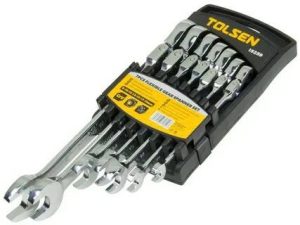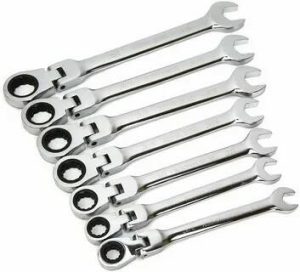A ratchet gear spanner wrench, also known as a ratchet wrench or ratchet spanner, is a versatile hand tool used for tightening or loosening fasteners such as nuts and bolts. It incorporates a ratchet mechanism that allows for continuous rotation in one direction while preventing backward movement, making it efficient and convenient to use. Here are some key features and benefits of ratchet gear spanner wrenches:
- Ratchet Mechanism: The ratchet mechanism enables the user to keep the wrench engaged with the fastener while only needing to move the handle back and forth within a limited arc. This makes it faster and more efficient compared to traditional wrenches, as it eliminates the need to remove and reposition the wrench for each turn.
- Reversible Design: Ratchet gear spanner wrenches usually have a reversible design, allowing you to change the direction of rotation without disconnecting the wrench from the fastener. By flipping a switch or lever on the wrench, you can quickly switch between tightening and loosening operations.
- Multiple Sizes and Configurations: Ratchet wrenches come in various sizes and configurations to accommodate different fastener sizes and shapes. They typically have a fixed-size opening or a set of interchangeable sockets or heads that can be attached to the wrench.
- Increased Accessibility: The compact size and slim profile of ratchet gear spanner wrenches make them suitable for accessing fasteners in tight or hard-to-reach areas where a traditional wrench may not fit. This makes them particularly useful in automotive repair, plumbing, and other mechanical or DIY tasks.
- Efficiency and Speed: With their ratchet mechanism, ratchet wrenches allow for quick and continuous rotation, reducing the time and effort required to tighten or loosen fasteners. This can be especially beneficial when working on projects that involve multiple fasteners or when dealing with time-sensitive tasks.
- Versatility: Ratchet gear spanner wrenches can be used with different types of fasteners, including hexagonal (hex) nuts and bolts, square nuts, and some specialty fasteners. They are available in both metric and imperial sizes to accommodate various measurement systems.
- Ergonomic Design: Many ratchet wrenches feature an ergonomic handle design that provides a comfortable grip and reduces hand fatigue during prolonged use. This makes them easier to handle and enhances overall user experience.
When using a ratchet gear spanner wrench, it’s important to ensure that the wrench is properly engaged with the fastener and that it is appropriate for the specific task and fastener size. It’s also crucial to use the correct socket or head size to prevent damage to the fastener and the wrench itself.
Kinds Ratchet Gear Spanner Wrench
There are several kinds of ratchet gear spanner wrenches available, each designed for specific applications and requirements. Here are some common types:
- Combination Ratchet Wrench: This type of ratchet wrench has a closed-end spanner on one side and a ratcheting box-end spanner on the other side. It offers versatility and convenience, allowing you to use either end depending on the specific fastener or task.
- Flex-Head Ratchet Wrench: A flex-head ratchet wrench has a flexible or pivoting head that can be adjusted to different angles. This feature allows for better access to fasteners in tight or hard-to-reach areas and enables the wrench to work around obstacles.
- Stubby Ratchet Wrench: Stubby ratchet wrenches are shorter in length compared to standard wrenches. They are designed for working in confined spaces where a longer wrench may not fit. Stubby wrenches are ideal for tasks that require strength and torque in limited spaces.
- Offset Ratchet Wrench: An offset ratchet wrench features an angled head, allowing for better clearance and access in tight spots. The offset design provides additional leverage and can make it easier to apply force when turning fasteners.
- Double-Ended Ratchet Wrench: This type of ratchet wrench has two different-sized ratchet heads at each end of the wrench. It eliminates the need for multiple wrenches and offers flexibility when working with different-sized fasteners.
- Adjustable Ratchet Wrench: An adjustable ratchet wrench, also known as an adjustable spanner or crescent wrench, has an adjustable jaw that can be set to different widths. It can accommodate a range of fastener sizes, providing versatility in various applications.
- Flare Nut Ratchet Wrench: Flare nut ratchet wrenches have a specialized design with an open-ended head that is wider and slightly curved to fit around tubing and fluid lines, such as brake lines or fuel lines. They allow for secure gripping and are commonly used in automotive and plumbing work.
These are just a few examples of the different kinds of ratchet gear spanner wrenches available. Each type offers specific features and benefits to meet different needs and applications. When selecting a ratchet wrench, consider the specific tasks you’ll be performing and choose a type that best suits your requirements.

What to look for when choosing
When choosing a ratchet gear spanner wrench, there are several factors https://www.buydo.eu to consider to ensure you select the right tool for your needs. Here are some key points to look for:
- Size: Consider the sizes of fasteners you commonly work with. Choose a ratchet wrench that offers the appropriate size range to accommodate the fasteners you will be tightening or loosening. Look for wrenches that have clear markings or color-coding for easy identification of sizes.
- Quality and Durability: Look for ratchet wrenches made from high-quality materials, such as chrome vanadium or high-carbon steel. These materials provide strength, durability, and resistance to wear and corrosion. Check for solid construction and smooth operation of the ratchet mechanism.
- Ratchet Mechanism Type: Determine whether you prefer a quick-release ratchet mechanism or a traditional switch-style mechanism. Quick-release mechanisms allow for easy socket changes, while switch-style mechanisms provide a more secure and lockable hold on the socket.
- Flexibility and Accessibility: If you anticipate working in tight spaces or with hard-to-reach fasteners, consider a ratchet wrench with a flex-head or offset design. These features provide better access and maneuverability in confined areas.
- Ergonomics: Look for ratchet wrenches with ergonomic handle designs that provide a comfortable grip and reduce hand fatigue during prolonged use. Cushioned or textured handles can offer better grip and control.
- Brand and Warranty: Consider reputable brands known for producing high-quality hand tools. Check customer reviews and feedback to ensure customer satisfaction. Look for ratchet wrenches that come with a warranty to protect against any defects or issues.
- Price: Set a budget based on your needs and the frequency of use. While it’s important to invest in a quality ratchet wrench, you don’t necessarily have to opt for the most expensive option. Compare prices and features to find the best value for your money.
- Sets or Individual Wrenches: Determine whether you need a set of ratchet wrenches or if individual wrenches will suffice. Sets often offer a range of sizes in a convenient package, while individual wrenches allow for more customization based on your specific needs.
Remember to consider the types of projects you will be working on and the specific requirements of your work. By considering these factors, you can choose a ratchet gear spanner wrench that is reliable, comfortable to use, and suitable for your intended applications.
How to use Ratchet Gear Spanner Wrench
Using a ratchet gear spanner wrench is relatively straightforward. Here’s a step-by-step guide on how to use it effectively:
- Select the Correct Size: Choose the appropriate size socket or spanner head that matches the size of the fastener you need to work with. Ensure a proper fit to avoid slipping and potential damage to the fastener or wrench.
- Attach the Socket or Spanner Head: If using a socket, place it onto the square drive end of the ratchet wrench. Ensure it is fully seated and securely attached. If using a spanner head, insert it onto the open-end or box-end of the ratchet wrench, depending on the design.
- Set the Ratchet Direction: Determine whether you need to tighten or loosen the fastener. Most ratchet wrenches have a switch or lever near the ratchet head that allows you to change the direction of the ratchet. Flip it to the desired direction (clockwise for tightening, counterclockwise for loosening).
- Position the Wrench: Place the socket or spanner head onto the fastener, ensuring it engages fully. Hold the wrench handle firmly with one hand while positioning the socket or spanner head onto the fastener with the other hand.
- Apply Force: Apply steady force in the appropriate direction to either tighten or loosen the fastener. Use the ratchet mechanism to your advantage by moving the handle back and forth within a limited arc, while maintaining contact with the fastener.
- Continue Ratcheting: Keep the wrench engaged with the fastener and continue ratcheting until the fastener is tightened or loosened to the desired level. The ratchet mechanism allows for continuous rotation in one direction without having to reposition the wrench for each turn.
- Switch Socket Positions (if necessary): If you need to switch to a different socket or spanner head size, release the current socket or spanner head by pressing the quick-release button (if applicable) or manually detaching it. Attach the new socket or spanner head and ensure it is securely in place.
- Repeat Steps 4-7 as Needed: If you have multiple fasteners to work with, repeat the process of positioning the wrench, applying force, and ratcheting until all the fasteners are tightened or loosened to the desired level.
- Release the Ratchet: When finished, release the pressure on the fastener and ensure the ratchet wrench is in the neutral position. This allows for easy removal of the wrench from the fastener.
It’s important to note that proper technique and using the appropriate amount of force are essential for effective use of a ratchet gear spanner wrench. Avoid excessive force that can lead to damage or injury. Always follow the manufacturer’s instructions and guidelines for safe and proper use of your specific ratchet wrench model.
